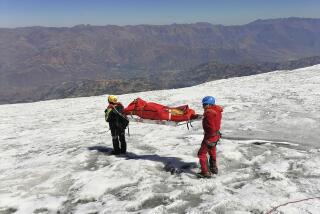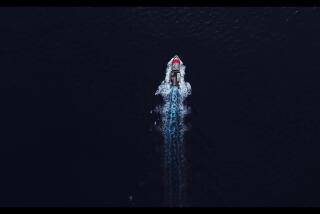Longing for Answers
The driveway was so much shorter than he had remembered.
That’s what the man was thinking. Business had taken the 38-year-old attorney to San Pedro, and a sentimental whim had taken him to the old neighborhood. He parked in front of the house remembering the last time he waved goodbye to his father. He was 10, and Daddy was backing out of the driveway, en route to a war that never was.
Memory sometimes seems to have a mystical dimension. After Albro Lundy III drove away from the old house that day two weeks ago and returned to his South Bay office, he learned with profoundly mixed emotions that the Laotian government had turned over to U.S. authorities what was believed to be the remains and telltale personal effects of Air Force Maj. Albro Lundy Jr.
So perhaps a mystery that began in December 1970 and was reignited by a startling photograph of three men 20 years later apparently may soon be resolved. Apparently, however, is still the operative word. For the Lundys and hundreds of other families whose loved ones vanished in the Vietnam War, “certainty” remains a wrenchingly elusive concept after decades of official lies and deception.
On this Veterans Day, it is worth remembering how many Americans would sooner be damned than to put the Vietnam War behind them. Those who would dismiss the question of whether America left any of its POW-MIAs behind as collective delusions encouraged by “Rambo” and other moneymaking myths might pause and consider one family’s extraordinary experience. It is easy to understand why Albro Lundy Jr.’s wife and six children, wary of the Pentagon’s history in resolving MIA cases, say they won’t be satisfied without an independent forensic analysis of the remains.
“My mother said, ‘They’re not going to bury a bunch of animal bones and call it Albro Lundy,’ ” the firstborn son says. “We’re on this.”
*
Their father was, they agree, “a very memorable guy.”
Albro Lundy III and his brother, William, 34, still call their father Daddy. They have searched for him for more than six years. The quest led William to live in Southeast Asia and work for an Australian construction firm in Laos so he could learn what became of his father. Albro’s efforts led him to testify in Washington, to travel to Hanoi with Muhammad Ali on a research mission, and to join his brother in Laos on another occasion.
A portrait of their father adorns Albro’s office. He is hale and hearty in his flight suit, smiling with his fingers plugging his ears against the roar of aircraft on the tarmac. Albro Lundy Jr. was a strapping 6-foot, 3-inch officer who had been an All-City basketball star at Van Nuys High in the 1950s before he enrolled at UCLA and married his college sweetheart. Whenever he was home, his sons say, Daddy would play with them for hours and buy a new toy every week.
After her husband’s A1-E gunship was shot down on Christmas Eve 1970, Johanna Lundy was told that he apparently had been unable to eject from his airplane. That was, at least, the official story.
The Lundys went on with their lives. Johanna studied law at night and went on to become a lawyer. The kids grew up, with Albro III following his mother’s career footsteps.
Twenty years later, Albro Lundy III received a strange call. Gladys and Jack Fleckenstein of Big Bear Lake wanted him to see a grainy photo that had been given to an American traveling in Cambodia. It appeared to show three middle-aged Caucasian men with a cryptic sign marked “25.5.90,” perhaps signifying the date the photo was taken.
The Fleckensteins were convinced one man might be their son, Navy Lt. Cmdr. Larry Stevens, who like Lundy was lost over Laos. Barbara Robertson of Santa Ana believed a second man to be her husband, Air Force Col. John L. Robertson, whose aircraft was downed in North Vietnam. The Lundys, initially doubtful, gradually became believers as well.
The families, frustrated in their dealings with government authorities, took their claims directly to the public in an extraordinary July 1991 news conference at the Westwood church where Albro and Johanna Lundy had exchanged their wedding vows. To many casual observers outside the families, the most striking resemblance between the images in the photograph and old photos of the missing men was the one purported to be Albro Lundy Jr.
“We had computer overlays done,” Albro Lundy III says. “You couldn’t prove it was him. But you couldn’t prove it wasn’t.”
The photo created a sensation. The POW-MIA controversy, dormant for many years, was back on Page 1. Newsweek put Johanna Lundy on its cover, holding a copy of the mysterious photo. “Hoping Against Hope,” the newsmagazine summed up. Washington took notice. Senate hearings were ordered, and investigators with the Pentagon’s Defense Intelligence Agency set out to determine whether the photo was genuine or a hoax.
A hoax, the Pentagon declared several weeks later. The photo, they said, was a doctored version of one that had appeared in a Soviet magazine. The families, however, were never satisfied with the explanation.
Their skepticism was born of experience. When Albro Lundy III appeared before a Senate committee investigating MIA questions, he explained his frustration researching his father’s disappearance. The cloak of secrecy extended to Lundy and more than 400 other Americans lost in covert operations in Laos that violated international law.
When Albro Lundy III finished testifying, an Air Force colonel handed him a set of documents that had been newly declassified amid the political pressure. The intelligence reports contradicted what the Lundys had been told 20 years before.
A parachute, in fact, had been spotted.
*
The official bottom line remains what it has been since Operation Homecoming ended in 1973. There is no confirmed or corroborated evidence, Pentagon officials say, that any Americans were held against their will after U.S. involvement in the war ended. Conspiracy theories abound among families of the missing and veterans, but there are more questions than answers.
William Lundy displays a poster he sometimes takes to veterans’ halls that shows photographs of the caves of Xam Nua, an area in Laos where Pentagon officials acknowledge at least two POWs were imprisoned. William and Albro say they saw some caves but were steered away from others at gunpoint, leaving them still wondering. Another poster shows a rubbing of his father’s dog tags and I.D. medallions he was wearing when he went down. William Lundy says his source tried to sell him the actual articles but he refused. To their knowledge, the Lundys say, the Pentagon investigators never had as much success researching their father’s case as William did acting as a private citizen.
Apart from the bones, the most intriguing evidence that was turned over may be Albro Lundy’s “blood chit”--a cloth or leather document sewn into his flight jacket that contains a message in several languages identifying the owner as a U.S. citizen and seeking assistance. This blood chit contained Albro Lundy Jr.’s I.D. number.
Albro Lundy III now finds himself once again slipping into past tense when he speaks of his father. They had hoped for a miracle--that he might walk out alive.
“He was truly an American hero,” his son says.
“Or is an American hero. However you want to phrase that.”
More to Read
Sign up for Essential California
The most important California stories and recommendations in your inbox every morning.
You may occasionally receive promotional content from the Los Angeles Times.










